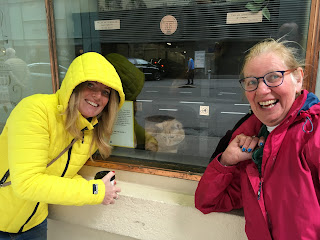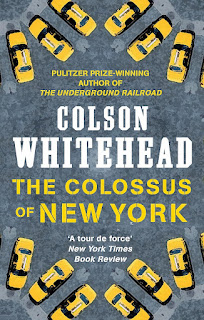When my daughter, Bex and I were in New York, we were determined to find out more about the literary side of the city, so we went to the Algonquin Hotel to meet Kevin, who knew all about writing and the Big Apple.

 The first thing we saw when we arrived at the Algonquin Hotel, was the cat in the window, snuggled up in a little bed for the world to see. This was Matilda the Algonquin cat, who has been resident for something like 40 years. Each time a cat dies, a new cat is brought from a refuge. If it is male, it's called Hamlet. If it is female, it's called Matilda. Each puss wanders the hotel at will, but has this special basket in the front window, looking out onto the road. The hotel is located on Times Square, with Yale, Harvard and the Yacht club headquarters nearby. The hotel façade is imposting and grand, and Matilda gives the place a more welcoming feel.
The first thing we saw when we arrived at the Algonquin Hotel, was the cat in the window, snuggled up in a little bed for the world to see. This was Matilda the Algonquin cat, who has been resident for something like 40 years. Each time a cat dies, a new cat is brought from a refuge. If it is male, it's called Hamlet. If it is female, it's called Matilda. Each puss wanders the hotel at will, but has this special basket in the front window, looking out onto the road. The hotel is located on Times Square, with Yale, Harvard and the Yacht club headquarters nearby. The hotel façade is imposting and grand, and Matilda gives the place a more welcoming feel.
'I wonder what Algonquin means,' mused my daughter. I laid down a dollar bet that the hotel name was of First Nations origin. But we were both puzzled – we'd done our homework and knew that the original inhabitants were called The Lenape, who had named the place Manahatta, meaning 'hilly island'.When Kevin arrived, this was the first question we had for him, and he had the answer; the Algonquin people lived in the Ottawa Valley for at least 8,000 years before Europeans arrived in North America. But the source of the word Algonquin is unclear. 'It is said to mean “at the place of spearing fishes and eels from the bow of a canoe”,' he said.
Great – I'd won my bet. I tucked my dollar winnings away as Kevin led us through the hotel foyer, all Art Deco dark wood paneling and golden lighting. He explained that the hotel had been built in 1902, was twelve stories tall, and shaped like an "H". Bex and I agreed that this was the hotel we'd stay at if we were ever to ship up in Manhattan again.
He walked us over to the famous literary round table, set in an alcove behind the reception area. 'This is where all the literati of New York would meet between the first and second world wars,' Keven told us. 'It was known for it's lively, witty, and sophisticated conversations.'
 |
| Dorothy Parker |
The group included Harpo Marx, Dorothy Parker and Harold Ross and his wife, Jane Grant, who founded The New Yorker. Also members were the actor Peggy Wood, George Kaufman, Margaret Leech Pulitzer and Donald Ogden Stewart who won an Oscar for The Philadelphia Story, Herman J. Mankiewicz, who won an Oscar for co-writing Citizen Kane. The rumour was that people like F Scot Fitzgerald, Ernest Hemingway and William Faulkner may have also dropped in for lunch; why not, these were wise-cracking wits who enjoyed pranks and word teasers, such Dorothy Parker's wordplay fun with: 'you can lead a horticulture, but you can't make her think…Brevity is the soul of lingerie…If you want to know what God thinks of money, just look at the people he gave it to…'
Above the large round table in the alcove is a painting of the club, showing many of its members.Keven took us for a walk around Hell's Kitchen, which is an inner-city area that was reputed to be like ‘the kitchens in Hell itself’ according to the NYPD of the prohibition era. There he pointed out where great writers of the time lived. He took us to the homes of James Thurber and Eugene O’Neil and F Scot Fitzgerald and his wife Zelda. A haunt of the young James Baldwin was his Aunt Barbara's candy shop near Fifth Avenue. She would later provide inspiration for the character of Florence in Baldwin’s first novel, Go Tell It on the Mountain, published in 1952. Colson Whitehead also lives in Manhattan, where he set his masterpiece, The Colossus. This opens with the 'awful truth' about being a Native New Yorker – 'it leaves you ruined for anywhere else.'
Most of these writers had written at times for the New Yorker, a magazine I know especially for its amazing short stories and brilliant cover illustrations. We found ourselves in the offices of The New Yorker, the New York magazine featuring journalism, commentary, criticism, essays, fiction and poetry. Although it's been around since 1925, it is still the pinnacle of good journalism, and has published some of the most famous short stories, including Annie Prouix's 'Brokeback Mountain' and Shirley Jackson's 'The Lottery'.
This office was the opposite of the Algonquin; it was plate glass and steel, giving off an atmosphere of being ultra-modern, professional and efficient. But Bex and I were already longing for Art Deco, and we found ourselves back at the Algonquin, ready to dine very close to (but sadly not on) the round table.





